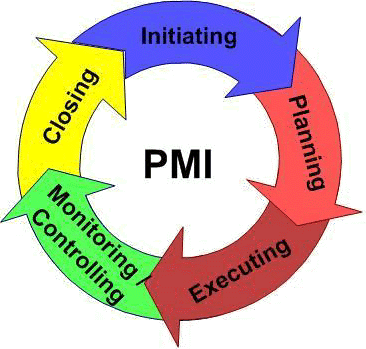
According to the Project Management Body of Knowledge (PMBOK), the foundation of project management rests upon the five phases that every project goes through:
- Project Initiation
- Project Planning
- Project Execution
- Monitoring & Controlling
- Project Closure
Project Initiation
This process group includes the basic groundwork necessary to create and define the project, usually on the organizational level. It will define the guidelines and criteria under which it will operate. Authorizations from the performing organization are given and funding is put in place. This phase includes the following tasks:
- Feasibility studies are performed to determine the economic viability of the project.
- Funding is finalized.
- An initial scope statement can be made, because executives generally have an idea what the project should accomplish when they authorize it.
- Any initial project boundaries are determined.
- Stakeholders are identified.
- Project offices are set up.
This phase produces a document called a Project Charter. This document contains the relevant project authorization and funding information, as well as scope statements and the like, to get the project going.
Project Planning
Upon authorization of the project, the project must be planned. This phase is usually the most underrated and underutilized. Inadequate project planning can have an outsized influence on the project success, and many cost and schedule overruns which look bad on the project manager and sponsor could have been avoided by better planning. Because of the potential for problems, it is important that the project manager carefully follows each item in the knowledge areas for the project planning phase.
This phase produces a document called a Project Management Plan. This is the master planning document which establishes how the project will be managed. In the PMBOK, this is the only phase in which all ten knowledge areas are used. The 12 essential components of a project management plan are:
- Scope Statement. This is a written statement of the work that the project encompasses. It should be clear to the reader what work is and is not part of the project.
- Critical Success Factors. How is project success defined? Budget and schedule are generally high on the list, but things like the satisfaction of certain stakeholders, preservation of the environment, or development of the project team members should be identified.
- Deliverables. These are the products the project was commissioned to produce. They should be listed and and their key features described to ensure there is no confusion.
- Work Breakdown Structure. The project is broken down into applicable phases and tasks to facilitate planning and tracking.
- Schedule. Each task is given a start and end date, which allows the project manager to estimate the completion date of the project.
- Budget. Each task is assigned a budget, which allows the project manager to estimate the overall cost of the project.
- Quality. Project quality criteria are assigned to each project deliverable, and the measurement criteria are determined.
- Human Resources Plan. The project team needs are determined and the team members are acquired.
- Stakeholder List. The project’s stakeholders are listed and their needs, wants and level of influence are analyzed.
- Communication Plan. The project’s communication needs are itemized and tracked.
- Risk Register. The risks to the project’s critical success factors (see above) are itemized and analyzed according to priority using the two components of risk, probability and impact.
- Procurement Plan. The project’s purchasing needs are determined, terms of reference are written and bids are solicited.
This is not an exhaustive list. The project management plan should outline anything that is relevant to the stakeholder’s perception of how the project will be managed. It is highly specific to individual industries and organizations. It should be distributed to the major project stakeholders, including the project sponsor, and receive their approval prior to project execution.
Project Execution
During project execution the project’s deliverables are produced.
The execution of the project requires coordination of human resources, managing stakeholder expectations, and dealing with project changes. The project manager must be on top of issues that arise, as well as making regular forecasts of future schedule and cost problems to deal with changes as far in advance as possible. Change requests must be handled and documented throughout this phase, and stakeholders must be kept informed according to the communications plan listed above.
During the project execution phase, most of the technical work gets done. Status updates and other project communications are sent to the relevant stakeholders according to the project management plan. Documents are stored and archived, and stakeholders are managed according to the plan.
Monitoring and Controlling
Throughout the project, the project manager must monitor and control the project work to ensure that project deliverables are on time, on budget and of acceptable quality. Also, stakeholders must be kept satisfied and the project team must be kept motivated and coherent. Monitoring and Controlling the project work occurs concurrently to the Execution phase, therefore the two Process Groups occur in parallel.
Because a project is defined as a temporary endeavor which produces a unique product, service, or result, there are two variables which inevitably factor high in the project success criteria:
- Schedule
- Cost
To ensure a project finishes on time and under budget, the PMBOK utilizes a method called called Earned Value Management. This method involves defining a time interval, usually one week or similar, and compiling two things:
- The percent complete of each task.
- The actual cost of each task.
Then the earned value metrics are calculated which tell the project manager how far ahead or behind schedule, and above or below cost, the project is relative to its planned schedule and cost at that point in time.
Other items that the project manager must deal with at the project status points are:
- The Scope Statement must be reconfirmed to minimize the dreaded Scope Creep.
- The Risk Register needs to be updated to strike off risks that did not occur and investigate any new ones that have appeared.
- Quality Control results should be analyzed and changes to processes initiated to keep product quality up to the standards identified in the project management plan.
- Any standard project communications like project status updates, investor circulars, and the like need to be delivered.
- Procurement Management of subcontractors and suppliers.
If changes are required to any part of the project as documented in the project management plan, they need to be documented and result in an updated plan. This includes changes to deadlines, costs, deliverables, and any other change to the project as originally envisioned.
Project Closure
As underrated phases go, Closing comes in a close second to Planning. There are almost always a handful of tasks involved in closing the project and moving on, and they are usually high on the visibility scale to executives and project sponsors.
- Releasing project resources.
- Transferring project documentation.
- Fulfilling contractual obligations and closing contracts.
- Submitting final details.
- Finalizing funding requirements.
- Documenting lessons learned.
Summary of Project Management Documents
In each phase, one or more project management documents are created. These consist of:
| Phase | Project Documents |
|---|---|
| Initiating |
|
| Planning |
|
| Execution |
|
| Monitoring |
|
| Closing |
|
The planning group is by far the largest within the PMBOK, and is the most intensive for the project manager. It contains more than half of the PMBOK’s 47 processes.






